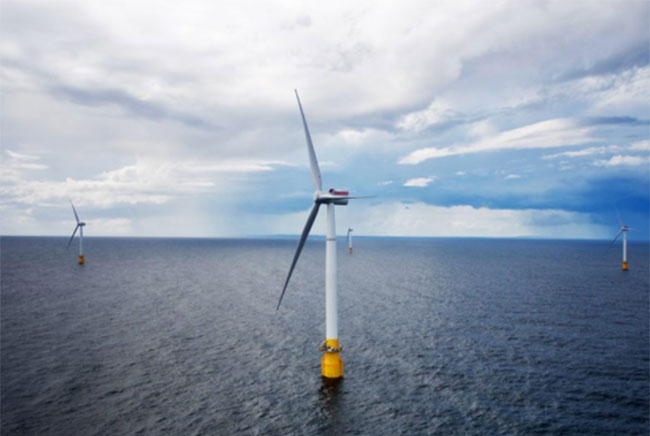
Photo: Hywind Scotland. Source: Equinor
The 11-turbine Hywind Tampen, the world’s first floating wind farm to power offshore oil and gas platforms, is close to producing its first power, according to Equinor’s latest press release.
A milestone was reached when the first subsea cables were laid by Subsea 7 and the connection was made to Gulfaks A in July.
The floating wind project entered the offshore construction phase in March with the transport and installation of the suction anchors at the site located about 140 kilometers off the Norwegian coast.
The 94.6 MW Hywind Tampen was initially scheduled to be completed by the end of 2022, but due to some deviations found in steel quality in four tower sections and supply chain bottlenecks, the first seven wind turbines will come on stream this year as planned, while the final four will be installed next spring, according to Equinor.
Equinor is also preparing for the start-up of the 3.6 GW Dogger Bank Wind Farm which is being developed 130 kilometres off the Yorkshire coast, the UK.
The offshore construction recently started with the installation of the first of 277 wind turbine foundations. The installation campaign is being led by Seaway 7 supported by DEME.
The project is expected to produce its first power in the second half of 2023, with commercial operations beginning in 2024 for Dogger Bank A, 2025 for Dogger Bank B, and 2026 for Dogger Bank C respectively.
The project is a joint venture between SSE Renewables (40 per cent), Equinor (40 per cent) and Eni Plenitude (20 per cent).
SSE Renewables is the lead operator for the development and construction of Dogger Bank Wind Farm, while Equinor will be the lead operator of the wind farm on completion for its expected operational life of around 35 years.
Equinor provided updates on both projects which are located in the North Sea at the ONS conference in Stavanger, Norway.
According to Pål Eitrheim, executive vice president for renewables at Equinor, the North Sea will continue to play a key role in Europe’s energy transition and security towards 2050.
Eitrheim added that the region is expanding from oil and gas production into a broad energy province utilising offshore wind resources.
“The North Sea is uniquely positioned to help meet European objectives of reliable, affordable and sustainable energy supplies. Renewable mega-projects like Dogger Bank and Hywind Tampen are nearing start-up, enabling Equinor to boost renewable energy to the European market”, said Eitrheim.
Equinor and partners recently launched Trollvind, a 1 GW floating wind farm offshore Bergen with a potential start-up of operations in 2027.
The partners already initiated feasibility studies to explore options for building a floating offshore wind farm in the Troll area and are aiming to have an investment decision in place next year.
According to Equinor, with an annual production of some 4.3 TWh and an onshore connection point, Trollvind could both power the offshore fields and deliver extra electricity to the Bergen region.
Transferring offshore wind power to shore may enable the possibility to build a larger wind farm than one directly connected to oil and gas installations offshore, Equinor said, adding that increasing the size of wind farms is a key factor in industrialising floating offshore wind and reducing costs.
-----The news is quoted from Offshore Energy by Adnan Memija (www.offshore-energy.biz)
Note: If you found anything violating your copyright, please contact us, we would remove them as soon as possible.




